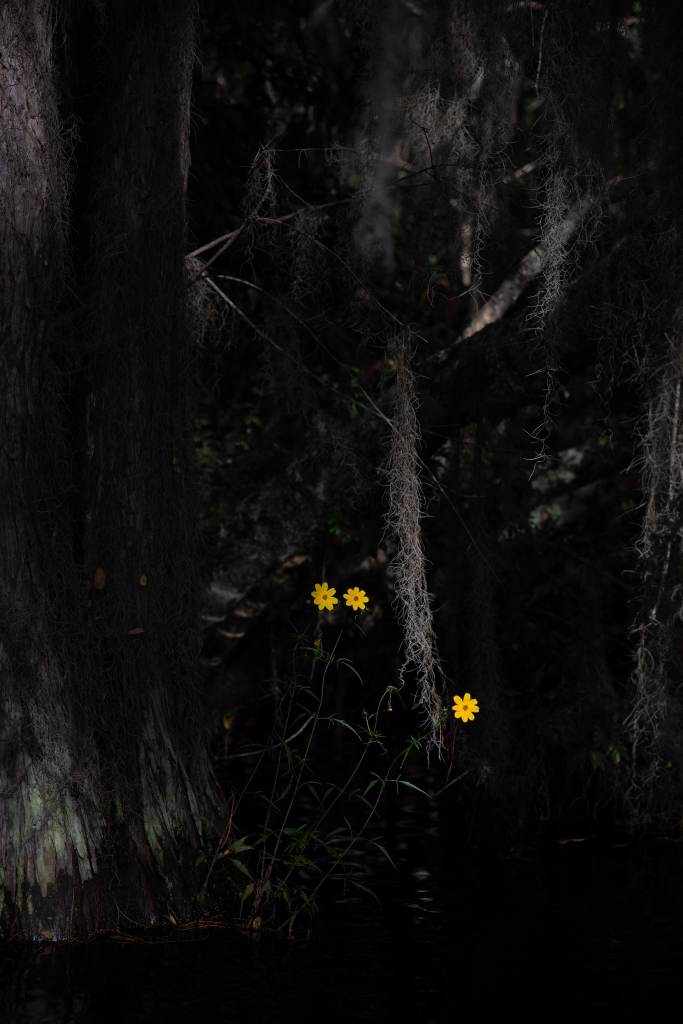
As the trail breaks into an open clearing, I feel a wave of relief. Trees draped in Spanish moss surround a prairie of tall grasses and bright yellow flowers. Thousands of lily pads carpet the water’s surface.
Mark and I spent the past six hours paddling to our first camping platform in the Okefenokee National Wildlife Refuge. I was warned that this leg would be difficult. Paddling twelve miles without the help of a current would be a challenge in even the best conditions. Per usual, I didn’t heed the warnings.
“Well, yea it’s marked ‘difficult’ but I think if you compare us to the general population we’d come out towards the top in terms of fitness,” I rationalized to Mark.
Correction: Mark comes out towards the top, I do not.
Exhausted but happy, I settle on the dock thinking about the 33 miles and four more days ahead of us.
Saturated strokes of pink, orange, and purple sweep across the sky. A barred owl’s “who cooks for youuu?” calls are eventually drowned out by the prehistoric squawks of sandhill cranes passing overhead. In their absence, insects and frogs fill the soundscape. A bat enters the scene swooping and diving to snatch up the gathering skeeters. As the last sunlight is finally extinguished, the star of the show arrives — a young gator emerges from the shoreline, lazily floating across the open water but always keeping a wary eye on us.
This is the Okefenokee magic I’ve heard so much about.
At 438,000 acres — about 680 square miles — Okefenokee is the largest blackwater swamp in North America. Straddling the Florida-Georgia line, it’s home to hundreds of plant and animal species, including some threatened and endangered. Being a peatland, it also stores a huge amount of carbon, filters water, and is mitigation for both flooding and drought. It’s no wonder why the refuge is designated as a Wetland of International Importance and has recently been nominated as a UNESCO World Heritage site.
Unfortunately, like many of our wetlands, the Okefenokee is under threat. Twin Pines Minerals has applied for mining permits nearby for the extraction of titanium and zirconium. While the company insists it can safely strip mine the 773 acres near the swamp without causing harm, experts disagree.
One of the most alarming consequences of the mine would be depleting the area’s groundwater, which would lower water levels, destroy vital habitat, and increase the chances of drought and wildfire.
This isn’t the first time the Okefenokee has been under threat. In the past decades, local communities, politicians, and activists have stepped in to defend her. Hopefully they will prevail again. The swamp’s accolades help in the fight, but most wetlands aren’t so lucky — particularly as of late.
This past spring, a Supreme Court ruling severed federal protections for up to 63 percent of wetlands by acreage in the United States in the Sackett v. EPA ruling. Under the Clean Water Act, wetlands were protected if they had a “significant nexus” — chemical, physical, and biological links — to larger bodies of water. The Court’s new definition includes only those with a “continuous surface connection” to a protected body of water.
Their ignorance is mind-blowing.
I’ve always had a deep love for nature. It’s where I experience the most joy and the most peace. It’s what I seek out to feel something and where I retreat to when I feel too much.
That’s why this constant destruction upsets me so much. I’m angry. And I want more people to be angry too. And I’m angry that more people aren’t angry.
While I loved our trip I can’t suppress the underlying sadness and anxiety thinking of what we will continue to lose in the name of “progress.” It’s difficult for me to process this duality of emotions, but I think Annie Proulx nailed it when saying “If your delight is in contemplating landscapes and wild places, the sweetness will be laced with ever-sharpening pain.”
For now I guess it’s best to keep plugging away at my work and savor those moments in the magic.



















